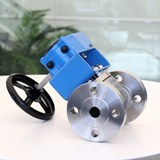Teollisuuden Voima Oyj (TVO) and Fortum have carried out a joint test of the first valve featuring a 3D printed housing at the Olkiluoto nuclear power plant. The supplier of the valve housing is Neles Oy. The valve is installed by TVO.
The actual valve inside the 3D printed housing is a standard T5-series ball valve of stainless steel.
Neles is at the forefront of using 3D printing in valve applications. The company started testing the suitability of 3D printing technologies for metal components years ago and supplied the first valves with non-pressure retaining, 3D printed metal components in 2018.
“The valve body is a pressure-retaining component and thus its material properties need to be well known. However, industry standards for 3D printed materials are under development. It has been necessary to test the valve body material extensively, and, for example, the tensile strength and impact resistance to make sure it is safe and reliable in the process,” says Jukka Borgman, Director of Technology Development at Neles.
“The 3D printed valve housing, as well as any other 3D components available in the future, provides us with an alternative in a situation where the number of suppliers for nuclear power plants is being reduced. This gives us the possibility to produce a unique component by printing it ourselves,” explains Life Cycle Management Engineer Dino Nerweyi from TVO.
Both the technology and knowledge of 3D materials have evolved to a sufficient degree to allow the use of 3D printing also in the nuclear power industry. Field tests provide a lot of valuable information on whether 3D printing could be used in the future to produce components with considerably shorter delivery times.
The size of the valve housing 3D printed for the project is 20 x 40 centimeters. The printer itself is the size of an SUV.
Courtesy of Teollisuuden Voima Oyj (TVO).


